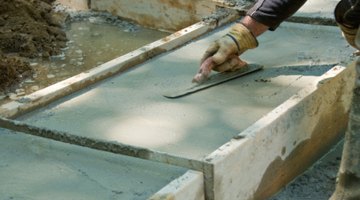How to Calculate Slump in Concrete
Slump is sometimes thought of as a measurement of the amount of water in concrete, but it is more accurate to think of slump as a measurement of concrete's consistency. Water, particle size and distribution, even the texture of the material all can affect the slump value.

To calculate slump, samples must be taken from the middle of the mixer discharge as opposed to the beginning or end. The test must be conducted quickly, within five minutes after collecting the samples, so that evaporation and absorption do not affect the slump value significantly.
Things You Will Need
- Bucket
- Wheelbarrow
- Slump cone
- Water
- Base surface
- 5/8-inch diameter steel rod
- Ruler or tape measure
-
Collect two or more concrete samples in a bucket as the concrete is being poured. Mix the samples in a wheelbarrow.
-
Dampen a slump cone with water. The cone is a conical form with an open top and an open bottom along with two tabs, one on either side, that are used to hold the form down. Place the cone with its widest end facing down on a base surface that is flat, smooth, non-absorbent and level. Moisten the base surface lightly with water.
-
Pour enough of the sample concrete into the cone to fill it one-quarter of the way. Tamp the concrete down by stroking it 25 times with a 5/8-inch diameter steel rod. A length of rebar would work well for this.
-
Fill the cone about halfway up with more of the concrete sample and tamp it down with the steel rod. Only penetrate through the newly poured concrete without disturbing the first pour.
-
Fill the cone to overflowing with the last of the concrete sample. Tamp it with the steel rod as well, only penetrating that layer and not the two previous layers.
-
Remove the excess concrete on top of the cone by shaving it off with the steel rod and clean the excess from around the base of the cone. Immediately raise the cone up with a quick, steady movement.
-
Place the cone next to the mound of wet concrete and put the steel bar level on top of it, extending over the top of the mound. Immediately measure the distance between the bottom of the steel bar and the top of the concrete mound. The distance, measured to the nearest 1/4 inch is the concrete slump.
-
Determine if the concrete was delivered with the slump ordered. For most applications, a slump between 2 to 3-1/2 inches is acceptable. This is considered a moist mix. Smaller slump values indicate a drier mix and larger values indicate a more fluid mix. The former may be necessary for heavily sloped applications while the latter is preferred by bricklayers.
The Drip Cap
- Slump is sometimes thought of as a measurement of the amount of water in concrete, but it is more accurate to think of slump as a measurement of concrete's consistency.
- The test must be conducted quickly, within five minutes after collecting the samples, so that evaporation and absorption do not affect the slump value significantly.
- Fill the cone to overflowing with the last of the concrete sample.
- Remove the excess concrete on top of the cone by shaving it off with the steel rod and clean the excess from around the base of the cone.
- Smaller slump values indicate a drier mix and larger values indicate a more fluid mix.
- The former may be necessary for heavily sloped applications while the latter is preferred by bricklayers.
References
Writer Bio
Robert Korpella has been writing professionally since 2000. He is a certified Master Naturalist, regularly monitors stream water quality and is the editor of freshare.net, a site exploring the Ozarks outdoors. Korpella's work has appeared in a variety of publications. He holds a bachelor's degree from the University of Arkansas.
Photo Credits
- Jupiterimages/Photos.com/Getty Images
- Jupiterimages/Photos.com/Getty Images
More Articles



